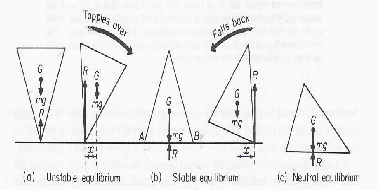
Ito illustrate the difference between the kinds of equilibrium consider a cone. If the cone can be stood so that it's centre of gravity is vertically above the point of contact with the ground, (a) above, then theoretically the cone will be in equilibrium, but it will not be a stable equilibrium because slight tilting either way causes the cone to topple. The force of gravity will cause a turning moment about the tip.
In diagram (b) above, if the cone is tilted then the moment dues to gravity about the point of contact with the ground will tend to right the cone again, so the cone will return to it's equilibrium position. A vertical line from the centre of gravity will still fall inside the base AB. It is not easy to topple the cone.
In © above the cone is lying on it's side. The base is a straight line, and if the cone is rolled into a new position (being round) the vertical line through the centre of gravity will still act through the 'base'. Whatever the position of the cone, the force of gravity exerts no moment about the 'base' as axis and however the cone is rolled the cone will remain in it's new position. This is described as neutral equilibrium.
Stability is vital for cars, trucks and buses. They must be designed to withstand tilt up to a certain angle before toppling. Famously a Mercedes Benz car once failed the 'elk test' so that it toppled when swerving to avoid an elk on on a test drive in Sweden. The car had to be redesigned to be more stable.
